0.学习目标
- 了解Thymeleaf的基本使用
- 实现商品详情页的渲染
- 知道页面静态化的作用
- 实现页面静态化功能
1.商品详情
当用户搜索到商品,肯定会点击查看,就会进入商品详情页,接下来我们完成商品详情页的展示,
1.2.商品详情页服务
商品详情浏览量比较大,并发高,我们会独立开启一个微服务,用来展示商品详情。
1.2.1.创建module
商品的详情页服务,命名为:ly-goods-page
1.2.2.pom依赖
<?xml version="1.0" encoding="UTF-8"?>
<project xmlns="http://maven.apache.org/POM/4.0.0"
xmlns:xsi="http://www.w3.org/2001/XMLSchema-instance"
xsi:schemaLocation="http://maven.apache.org/POM/4.0.0 http://maven.apache.org/xsd/maven-4.0.0.xsd">
<parent>
<artifactId>leyou</artifactId>
<groupId>com.leyou.parent</groupId>
<version>1.0.0-SNAPSHOT</version>
</parent>
<modelVersion>4.0.0</modelVersion>
<groupId>com.leyou.service</groupId>
<artifactId>ly-goods-page</artifactId>
<version>1.0.0-SNAPSHOT</version>
<dependencies>
<dependency>
<groupId>org.springframework.boot</groupId>
<artifactId>spring-boot-starter-web</artifactId>
</dependency>
<dependency>
<groupId>org.springframework.boot</groupId>
<artifactId>spring-boot-starter-thymeleaf</artifactId>
</dependency>
<dependency>
<groupId>org.springframework.cloud</groupId>
<artifactId>spring-cloud-starter-netflix-eureka-client</artifactId>
</dependency>
<dependency>
<groupId>org.springframework.cloud</groupId>
<artifactId>spring-cloud-starter-openfeign</artifactId>
</dependency>
<dependency>
<groupId>com.leyou.service</groupId>
<artifactId>ly-item-interface</artifactId>
<version>${leyou.latest.version}</version>
</dependency>
</dependencies>
</project>
1.2.3.编写启动类:
@EnableDiscoveryClient
@EnableFeignClients
@SpringBootApplication
public class LyGoodsPage {
public static void main(String[] args) {
SpringApplication.run(LyGoodsPage.class, args);
}
}
1.2.4.application.yml文件
sringboot版本 2.1.0以上 添加以下内容
main:
allow-bean-definition-overriding: true
server:
port: 8084
spring:
application:
name: page-service
thymeleaf:
cache: false
main:
allow-bean-definition-overriding: true
eureka:
client:
service-url:
defaultZone: http://127.0.0.1:10086/eureka
instance:
lease-renewal-interval-in-seconds: 5 # 每隔5秒发送一次心跳
lease-expiration-duration-in-seconds: 10 # 10秒不发送就过期
prefer-ip-address: true
ip-address: 127.0.0.1
instance-id: ${spring.application.name}.${server.port}
1.2.5.页面模板:
建议从博主的github 下载一下该页面,编写过程中前端存在各种坑
https://github.com/smallmartial/lyshop.git
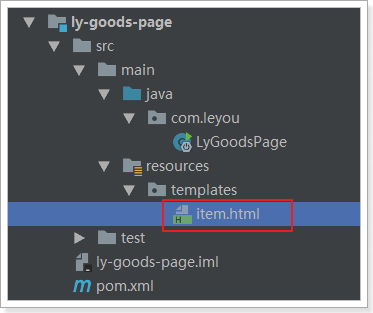
1.3.页面跳转
1.3.1.修改页面跳转路径
首先我们需要修改搜索结果页的商品地址,目前所有商品的地址都是:http://www.leyou.com/item.html
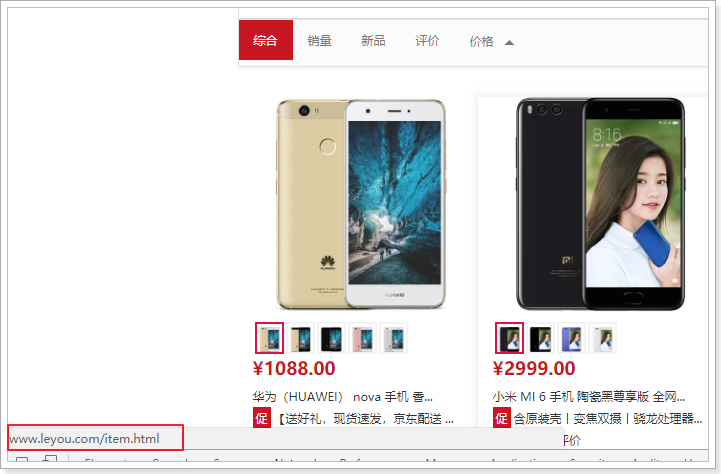
我们应该跳转到对应的商品的详情页才对。
那么问题来了:商品详情页是一个SKU?还是多个SKU的集合?
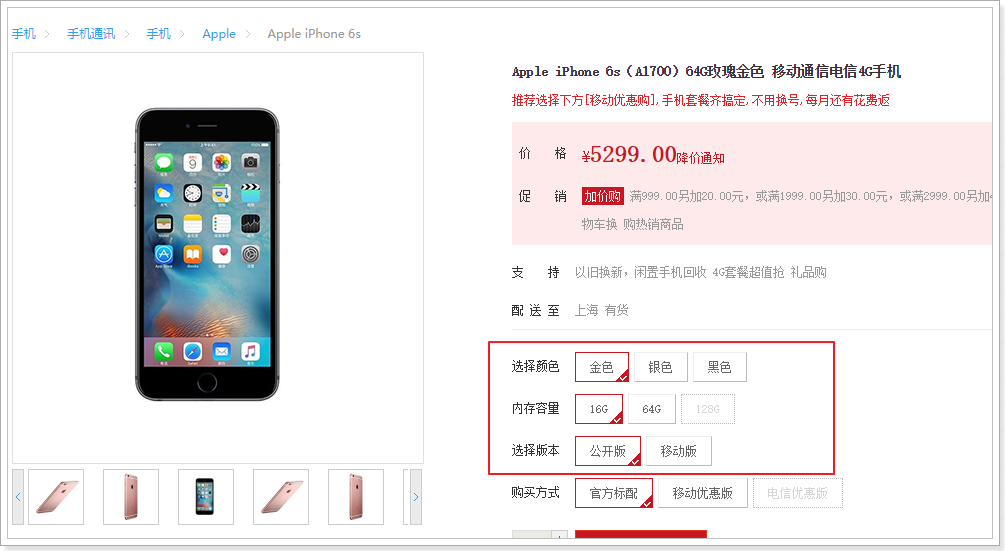
通过详情页的预览,我们知道它是多个SKU的集合,即SPU。
所以,页面跳转时,我们应该携带SPU的id信息。
例如:http://www.leyou.com/item/2314123.html
这里就采用了路径占位符的方式来传递spu的id,我们打开search.html,修改其中的商品路径:
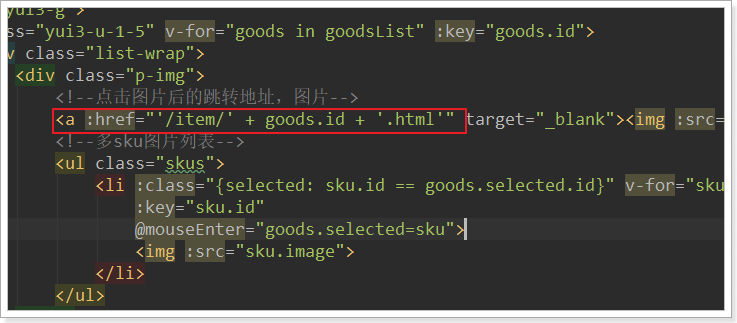
刷新页面后在看:
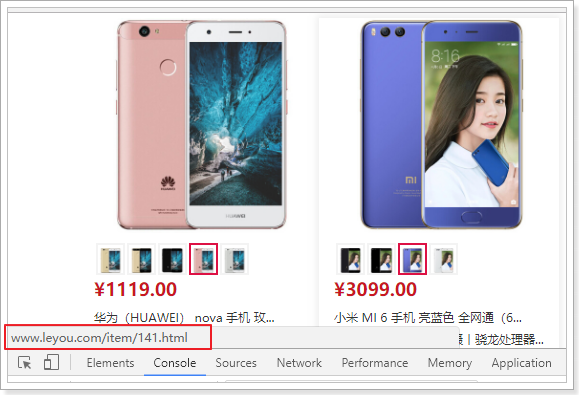
1.3.2.nginx反向代理
接下来,我们要把这个地址指向我们刚刚创建的服务:ly-goods-page,其端口为8084
我们在nginx.conf中添加一段逻辑:
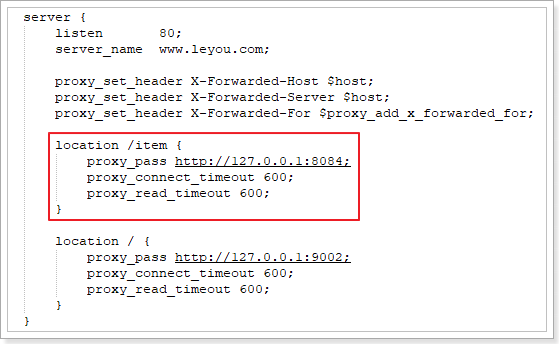
把以/item开头的请求,代理到我们的8084端口
1.3.3.编写跳转controller
在ly-goods-page中编写controller,接收请求,并跳转到商品详情页:
@Controller
@RequestMapping("item")
public class GoodsController {
/**
* 跳转到商品详情页
* @param model
* @param id
* @return
*/
@GetMapping("{id}.html")
public String toItemPage(Model model, @PathVariable("id")Long id){
return "item";
}
}
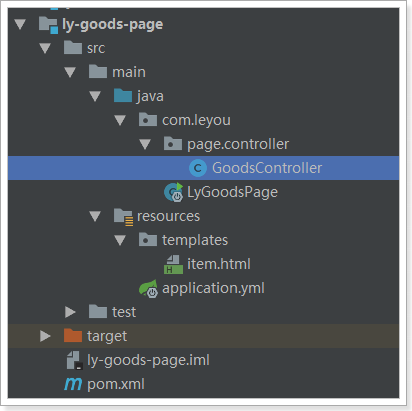
1.3.4.测试
启动ly-goods-page,点击搜索页面商品,看是能够正常跳转:
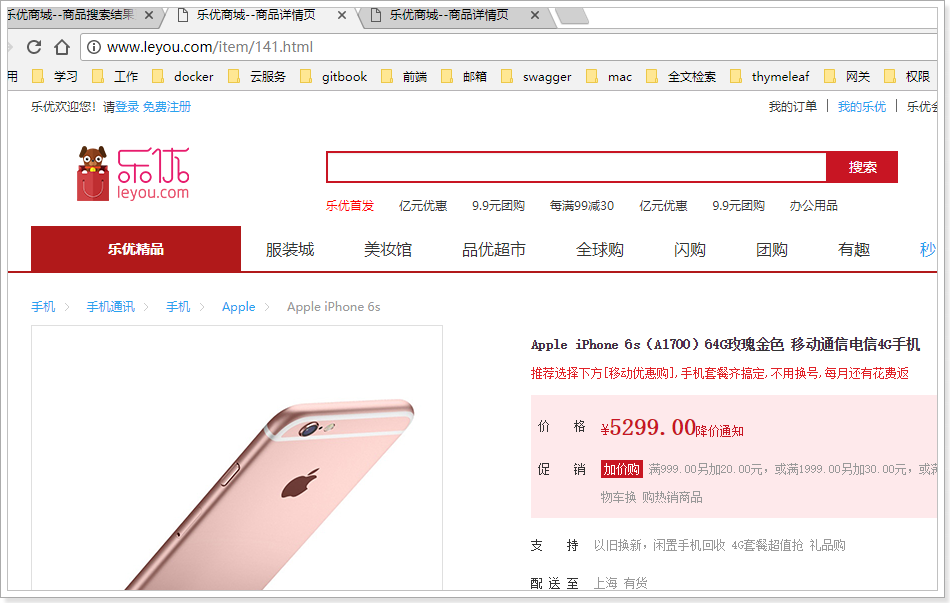
现在看到的依然是静态的数据。我们接下来开始页面的渲染
1.4.封装模型数据
首先我们一起来分析一下,在这个页面中需要哪些数据
我们已知的条件是传递来的spu的id,我们需要根据spu的id查询到下面的数据:
- spu信息(无)
- spu的详情
- spu下的所有sku
- 品牌
- 商品三级分类
- 商品规格参数、规格参数组(无)
1.4.1.商品微服务提供接口
查询spu接口
以上所需数据中,查询spu的接口目前还没有,我们需要在商品微服务中提供这个接口:
GoodsApi
/**
* 根据spu的id查询spu
* @param id
* @return
*/
@GetMapping("spu/{id}")
Spu querySpuById(@PathVariable("id") Long id);
GoodsController
@GetMapping("spu/{id}")
public ResponseEntity<Spu> querySpuById(@PathVariable("id") Long id){
Spu spu = this.goodsService.querySpuById(id);
if(spu == null){
return new ResponseEntity<>(HttpStatus.NOT_FOUND);
}
return ResponseEntity.ok(spu);
}
GoodsService
public Spu querySpuById(Long id) {
Spu spu = spuMapper.selectByPrimaryKey(id);
//查询sku
spu.setSkus(querySkuSpuId(id));
//查询detail
spu.setSpuDetail(querySpuDetailById(id));
return spu;
}
查询规格参数组
我们在页面展示规格时,需要按组展示:
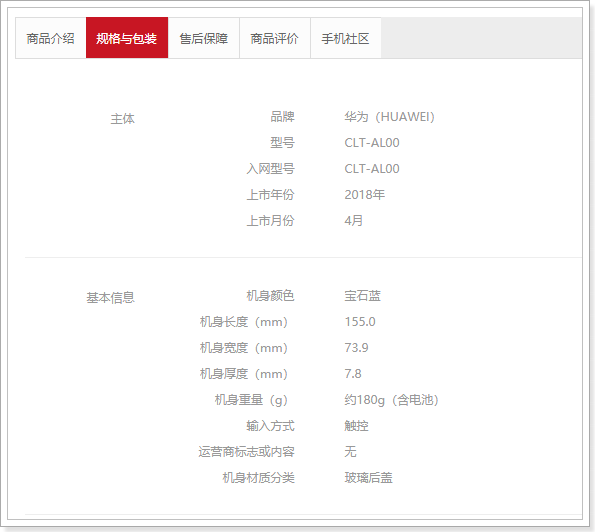
组内有多个参数,为了方便展示。我们提供一个接口,查询规格组,同时在规格组中持有组内的所有参数。
拓展
SpecGroup类:
我们在SpecGroup中添加一个SpecParam的集合,保存改组下所有规格参数
@Table(name = "tb_spec_group")
public class SpecGroup {
@Id
@GeneratedValue(strategy = GenerationType.IDENTITY)
private Long id;
private Long cid;
private String name;
@Transient
private List<SpecParam> params; // 该组下的所有规格参数集合
}
然后提供查询接口:
SpecificationAPI:
public interface SpecificationApi {
@GetMapping("spec/params")
List<SpecParam> querySpecSpecParam(
@RequestParam(value = "gid",required = false) Long gid,
@RequestParam(value="cid", required = false) Long cid,
@RequestParam(value="searching", required = false) Boolean searching,
@RequestParam(value="generic", required = false) Boolean generic);
@GetMapping("spec/group")
List<SpecGroup> queryGroupByCid(@RequestParam("cid") Long cid);
}
SpecificationController
@GetMapping("group")
public ResponseEntity<List<SpecGroup>> queryListByCid(@RequestParam("cid") Long cid){
return ResponseEntity.ok(specificationService.queryListByCid(cid));
}
SpecificationService
public List<SpecGroup> queryListByCid(Long cid) {
//查询规格参数
List<SpecGroup> specGroups = queryBySpecGroups(cid);
//查询当前分类下的参数
List<SpecParam> specParams = querySpecParams(null, cid, null,null);
//先把规格参数变成map,map的key是规格组的id,map的值是组下的所有参数
Map<Long,List<SpecParam>> map = new HashMap<>();
for (SpecParam specParam : specParams) {
if (!map.containsKey(specParam.getGroupId())){
map.put(specParam.getGroupId(),new ArrayList<>());
}
map.get(specParam.getGroupId()).add(specParam);
}
//填充param到group
for (SpecGroup specGroup : specGroups) {
specGroup.setParams(map.get(specGroup.getId()));
}
return specGroups;
}
}
1.4.2.创建FeignClient
我们在ly-goods-page服务中,创建FeignClient:
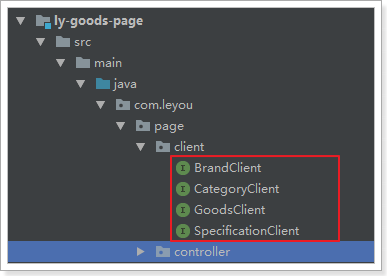
BrandClient:
@FeignClient("item-service")
public interface BrandClient extends BrandApi {
}
CategoryClient
@FeignClient("item-service")
public interface CategoryClient extends CategoryApi {
}
GoodsClient:
@FeignClient("item-service")
public interface GoodsClient extends GoodsApi {
}
SpecificationClient:
@FeignClient(value = "item-service")
public interface SpecificationClient extends SpecificationApi{
}
1.4.3.封装数据模型
我们创建一个GoodsService,在里面来封装数据模型。
这里要查询的数据:
-
SPU
-
SKU集合
-
商品分类
- 这里值需要分类的id和name就够了,因此我们查询到以后自己需要封装数据
-
品牌
-
规格组
- 查询规格组的时候,把规格组下所有的参数也一并查出,上面提供的接口中已经实现该功能,我们直接调
-
sku的特有规格参数
有了规格组应该不需要再查询规格参数才对了,为什么这里还要查询?
因为在SpuDetail中的SpecialSpec中,是以id作为规格参数id作为key,如图:
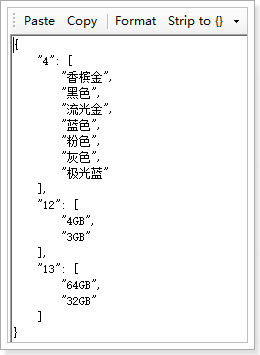
但是,在页面渲染时,需要知道参数的名称,如图:

我们就需要把id和name一一对应起来,因此需要额外查询sku的特有规格参数,然后变成一个id:name的键值对格式。也就是一个Map,方便将来根据id查找!
Service代码
/**
* @Author smallmartial
* @Date 2019/4/20
* @Email smallmarital@qq.com
*/
@Service
public class PageService {
@Autowired
private BrandClient brandClient;
@Autowired
private CategoryClient categoryClient;
@Autowired
private GoodClient goodsClient;
@Autowired
private SpecificationClient specClient;
public Map<String, Object> loadModel(Long id) {
Map<String,Object> model = new HashMap<>();
//查询spu
Spu spu = goodsClient.querySpuById(id);
//查询skus
List<Sku> skus =spu.getSkus();
//查询详情
SpuDetail detail = spu.getSpuDetail();
// String specialSpec = detail.getSpecialSpec();
//查询brand
Brand brand = brandClient.queryBrandById(spu.getBrandId());
// Brand brand = this.brandClient.queryBrandByIds(Collections.singletonList(spu.getBrandId())).get(0);
// 准备品牌数据
List<Brand> brands = this.brandClient.queryBrandByIds(
Arrays.asList(spu.getBrandId()));
//查询商品分类
List<Category> categories = categoryClient.queryCategoryByIds(
Arrays.asList(spu.getCid1(), spu.getCid2(), spu.getCid3()));
//查询规格参数
List<SpecGroup> specs = specClient.queryGroupByCid(spu.getCid3());
//查询规格参数(附加)
// 查询规格组及组内参数
List<SpecGroup> groups = specClient.queryGroupByCid(spu.getCid3());
// 查询商品分类下的特有规格参数
List<SpecParam> params =
this.specClient.querySpecSpecParam(null, spu.getCid3(), null, false);
// 处理成id:name格式的键值对
Map<Long,String> paramMap = new HashMap<>();
for (SpecParam param : params) {
paramMap.put(param.getId(), param.getName());
}
/**
* 对于规格属性的处理需要注意以下几点:
* 1. 所有规格都保存为id和name形式
* 2. 规格对应的值保存为id和value形式
* 3. 都是map形式
* 4. 将特有规格参数单独抽取
*/
//获取所有规格参数,然后封装成id和name形式的数据
// String allSpecJson = detail.getSpecialSpec();
// List<Map<String, Object>> allSpecs = JsonUtils
// .nativeRead(allSpecJson, new TypeReference<List<Map<String, Object>>>() {});
// Map<Integer,String> specName = new HashMap<>();
// Map<Integer,Object> specValue = new HashMap<>();
// this.getAllSpecifications(allSpecs,specName,specValue);
//获取特有规格参数
model.put("title",spu.getTitle());
model.put("subTitle",spu.getSubTitle());
model.put("skus",skus);
model.put("detail",detail);
model.put("brand",brand);
model.put("categories",categories);
model.put("specs",specs);
model.put("paramMap", paramMap);
model.put("groups", groups);
// model.put("specialSpec");
return model;
}
}
然后在controller中把数据放入model:
@Controller
@RequestMapping("item")
public class GoodsController {
@Autowired
private GoodsService goodsService;
/**
* 跳转到商品详情页
* @param model
* @param id
* @return
*/
@GetMapping("{id}.html")
public String toItemPage(Model model, @PathVariable("id")Long id){
// 加载所需的数据
Map<String, Object> modelMap = this.goodsService.loadModel(id);
// 放入模型
model.addAllAttributes(modelMap);
return "item";
}
}
1.4.4.页面测试数据
我们在页面中先写一段JS,把模型中的数据取出观察,看是否成功:
<script th:inline="javascript">
const a = /*[[${groups}]]*/ null;
const b = /*[[${paramMap}]]*/ null;
const c = /*[[${categories}]]*/ null;
const d = /*[[${spu}]]*/ null;
const e = /*[[${spuDetail}]]*/ null;
const f = /*[[${skus}]]*/ null;
const g = /*[[${brand}]]*/ null;
</script>
然后查看页面源码:

数据都成功查到了!
1.5.渲染面包屑
在商品展示页的顶部,有一个商品分类、品牌、标题的面包屑
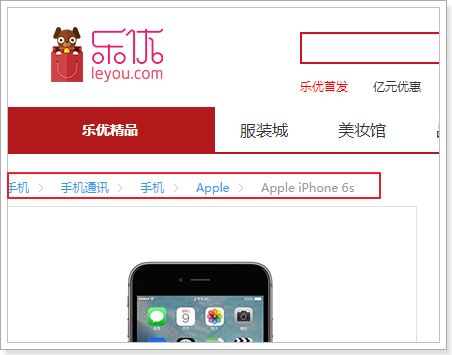
其数据有3部分:
- 商品分类
- 商品品牌
- spu标题
我们的模型中都有,所以直接渲染即可(页面37行开始):
<div class="crumb-wrap">
<ul class="sui-breadcrumb">
<li th:each="category : ${categories}">
<a href="#" th:text="${category.name}">手机</a>
</li>
<li>
<a href="#" th:text="${brand.name}">Apple</a>
</li>
<li class="active" th:text="${spu.title}">Apple iPhone 6s</li>
</ul>
</div>
1.6.渲染商品列表
先看下整体效果:
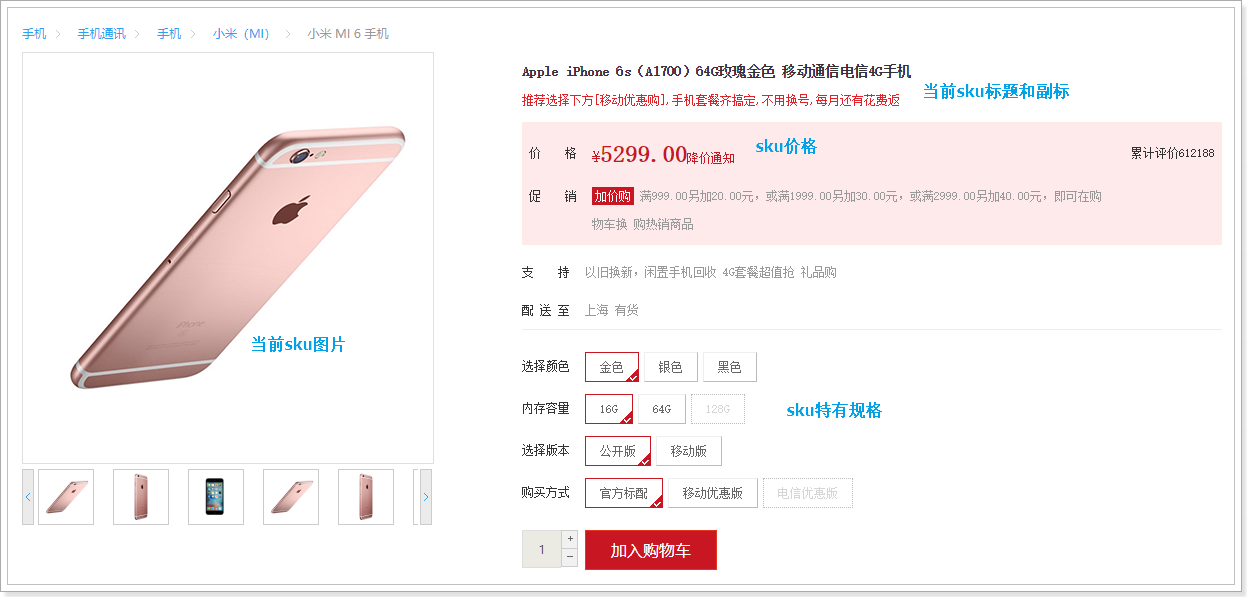
这个部分需要渲染的数据有5块:
- sku图片
- sku标题
- 副标题
- sku价格
- 特有规格属性列表
其中,sku 的图片、标题、价格,都必须在用户选中一个具体sku后,才能渲染。而特有规格属性列表可以在spuDetail中查询到。而副标题则是在spu中,直接可以在页面渲染
因此,我们先对特有规格属性列表进行渲染。等用户选择一个sku,再通过js对其它sku属性渲染
1.6.1.副标题
副标题是在spu中,所以我们直接通过Thymeleaf渲染:
在第87行左右:
<div class="news"><span th:utext="${spu.subTitle}"></span></div>
副标题中可能会有超链接,因此这里也用th:utext来展示,效果:

1.6.2.渲染规格属性列表
规格属性列表将来会有事件和动态效果。我们需要有js代码参与,不能使用Thymeleaf来渲染了。
因此,这里我们用vue,不过需要先把数据放到js对象中,方便vue使用
初始化数据
我们在页面的head中,定义一个js标签,然后在里面定义变量,保存与sku相关的一些数据:
<script th:inline="javascript">
// sku集合
const skus = /*[[${skus}]]*/ [];
const paramMap = /*[[${paramMap}]]*/ {};
const specialSpec= JSON.parse(/*[[${detail.specialSpec}]]*/ "");
</script>
-
specialSpec:这是SpuDetail中与唯一与Sku相关的数据
因此我们并没有保存整个spuDetail,而是只保留了这个属性,而且需要手动转为js对象。
-
paramMap:规格参数的id和name对,方便页面根据id获取参数名
-
specialSpec:特有规格参数集合
我们来看下页面获取的数据:
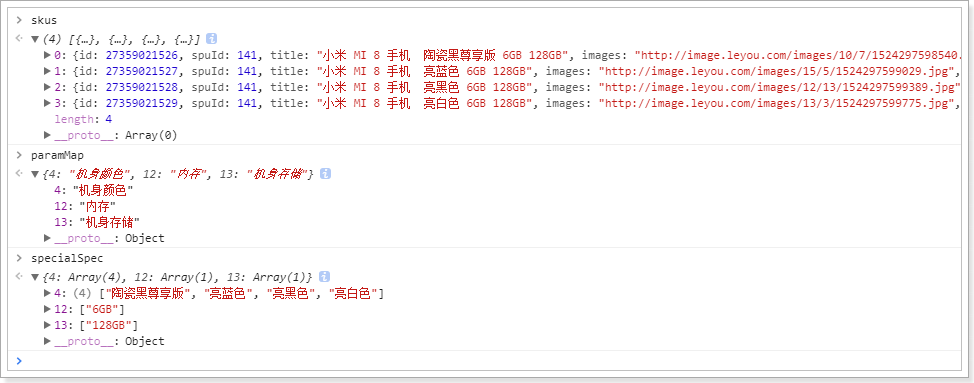
通过Vue渲染
我们把刚才获得的几个变量保存在Vue实例中:
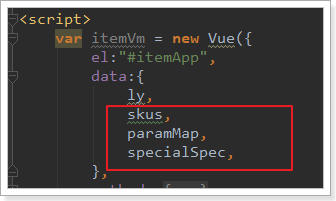
然后在页面中渲染:
<div id="specification" class="summary-wrap clearfix">
<dl v-for="(v,k) in specialSpec" :key="k">
<dt>
<div class="fl title">
<i v-text="paramMap[k]"></i>
</div>
</dt>
<dd v-for="(o,j) in v" :key="j">
<a href="javascript:;" class="selected">
{{o}}<span title="点击取消选择"> </span>
</a>
</dd>
</dl>
</div>
然后刷新页面查看:
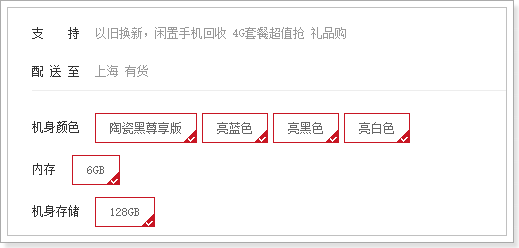
数据成功渲染了。不过我们发现所有的规格都被勾选了。这是因为现在,每一个规格都有样式:selected,我们应该只选中一个,让它的class样式为selected才对!
那么问题来了,我们该如何确定用户选择了哪一个?
1.6.3.规格属性的筛选
分析
规格参数的格式是这样的:

每一个规格项是数组中的一个元素,因此我们只要保存被选择的规格项的索引,就能判断哪个是用户选择的了!
我们需要一个对象来保存用户选择的索引,格式如下:
{
"4":0,
"12":0,
"13":0
}
但问题是,第一次进入页面时,用户并未选择任何参数。因此索引应该有一个默认值,我们将默认值设置为0。
我们在head的script标签中,对索引对象进行初始化:

然后在vue中保存:

页面改造
我们在页面中,通过判断indexes的值来判断当前规格是否被选中,并且给规格绑定点击事件,点击规格项后,修改indexes中的对应值:
<div id="specification" class="summary-wrap clearfix">
<dl v-for="(v,k) in specialSpec" :key="k">
<dt>
<div class="fl title">
<i v-text="k"></i>
</div>
</dt>
<dd v-for="(o,j) in v" :key="j" @click="indexes[k]=j">
<a href="javascript:;" :class="{selected: j === indexes[k]}">
{{o}}<span v-show="j === indexes[k]" title="点击取消选择"> </span>
</a>
</dd>
</dl>
</div>
效果:
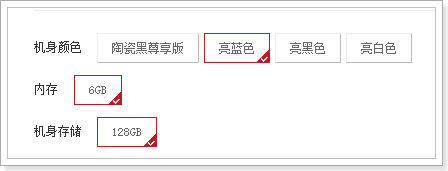
vue实例中的索引会随着你的点击而变化:
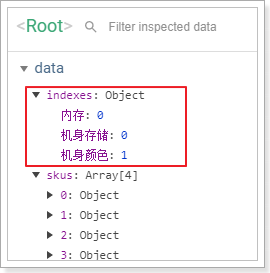
1.6.4.确定SKU
在我们设计sku数据的时候,就已经添加了一个字段:indexes:
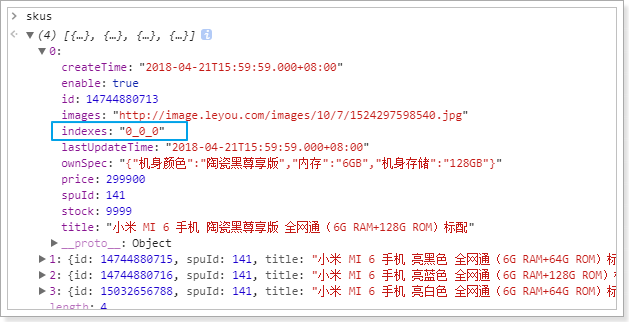
这其实就是规格参数的索引组合。
而我们在页面中,用户点击选择规格后,就会把对应的索引保存起来:

因此,我们可以根据这个indexes来确定用户要选择的sku
我们在vue中定义一个计算属性,来计算与索引匹配的sku:
computed:{
sku(){
const index = Object.values(this.indexes).join("_");
return this.skus.find(s => s.indexes = index);
}
}
在浏览器工具中查看:
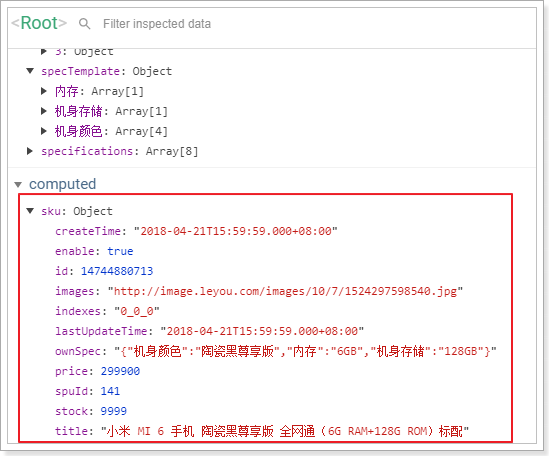
1.6.5.渲染sku列表
既然已经拿到了用户选中的sku,接下来,就可以在页面渲染数据了
图片列表
商品图片是一个字符串,以,分割,页面展示比较麻烦,所以我们编写一个计算属性,将图片字符串变成数组:
images(){
return this.sku.images ? this.sku.images.split(",") : ['']
}
页面改造:
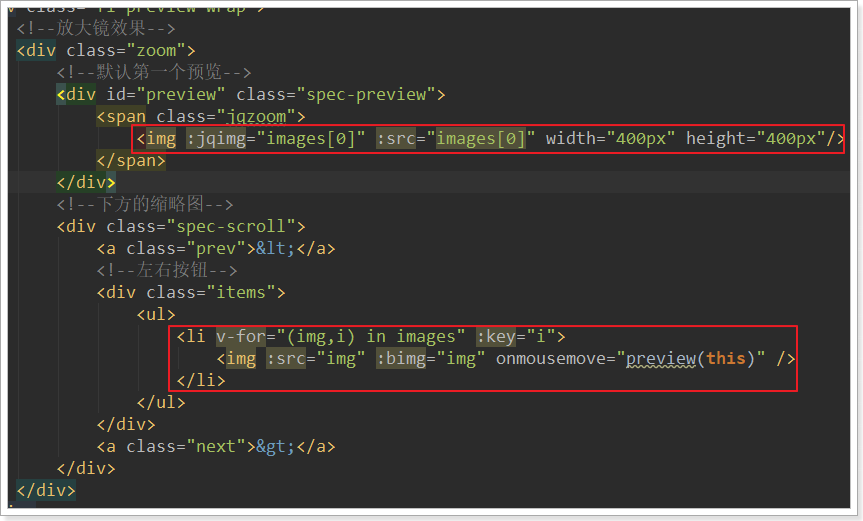
效果:
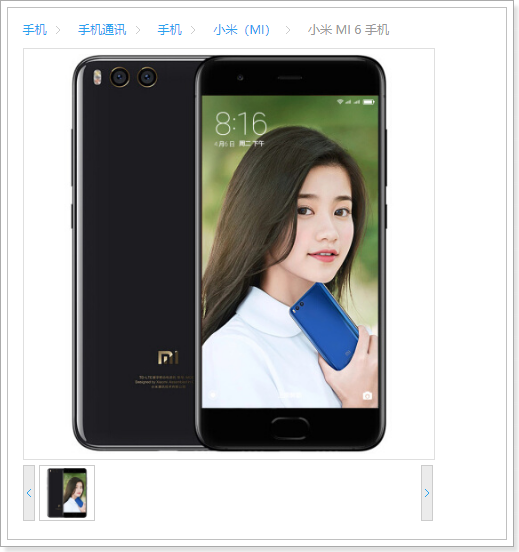
标题和价格
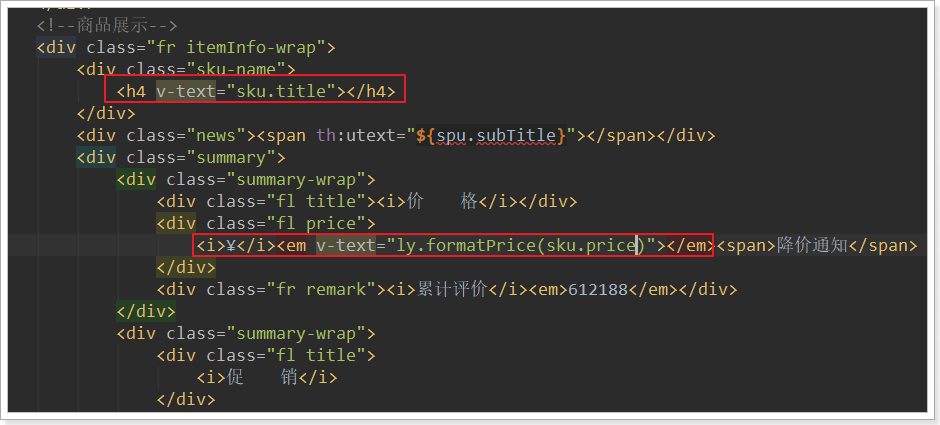
完整效果
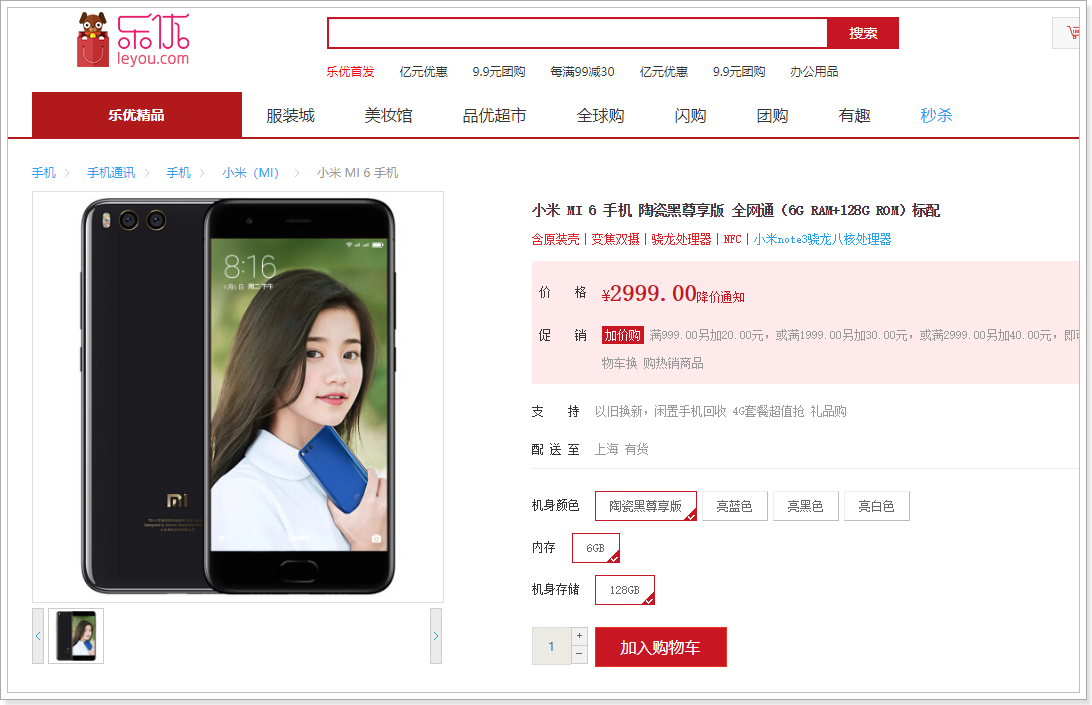
1.7.商品详情
商品详情页面如下图所示:

分成上下两部分:
- 上部:展示的是规格属性列表
- 下部:展示的是商品详情
1.7.2.商品详情
商品详情是HTML代码,我们不能使用 th:text,应该使用th:utext
在页面的第420行左右:
<!--商品详情-->
<div class="intro-detail" th:utext="${detail.description}">
</div>
最终展示效果:
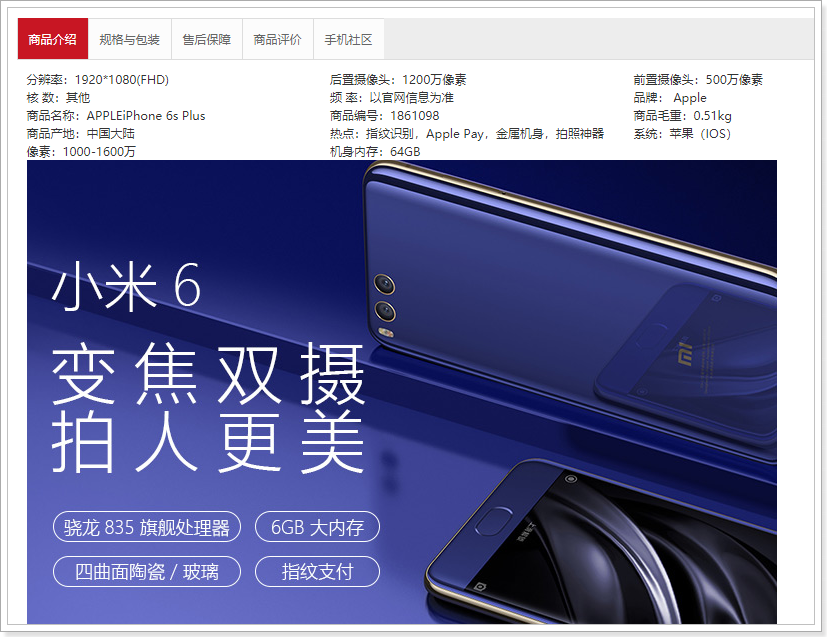
1.8.规格包装:
规格包装分成两部分:
- 规格参数
- 包装列表
而且规格参数需要按照组来显示
1.8.1.规格参数
最终的效果:

我们模型中有一个groups,跟这个数据结果很像:

分成8个组,组内都有params,里面是所有的参数。不过,这些参数都没有值!
规格参数的值分为两部分:
- 通用规格参数:保存在SpuDetail中的genericSpec中
- 特有规格参数:保存在sku的ownSpec中
我们需要把这两部分值取出来,放到groups中。
因为sku是动态的,所以我们编写一个计算属性,来进行值的组合:
groups(){
groups.forEach(group => {
group.params.forEach(param => {
if(param.generic){
// 通用属性,去spu的genericSpec中获取
param.v = this.genericSpec[param.id] || '其它';
}else{
// 特有属性值,去SKU中获取
param.v = JSON.parse(this.sku.ownSpec)[param.id]
}
})
})
return groups;
}
然后在页面渲染:
<div class="Ptable">
<div class="Ptable-item" v-for="group in groups" :key="group.name">
<h3>{{group.name}}</h3>
<dl>
<div v-for="p in group.params">
<dt>{{p.name}}</dt><dd>{{p.v + (p.unit || '')}}</dd>
</div>
</dl>
</div>
</div>
1.8.2.包装列表
包装列表在商品详情中,我们一开始并没有赋值到Vue实例中,但是可以通过Thymeleaf来渲染
<div class="package-list">
<h3>包装清单</h3>
<p th:text="${detail.packingList}"></p>
</div>
最终效果:
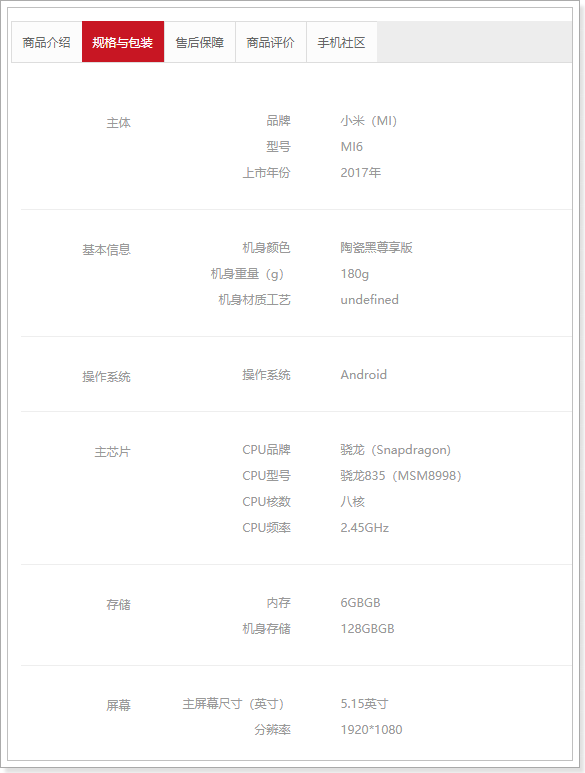
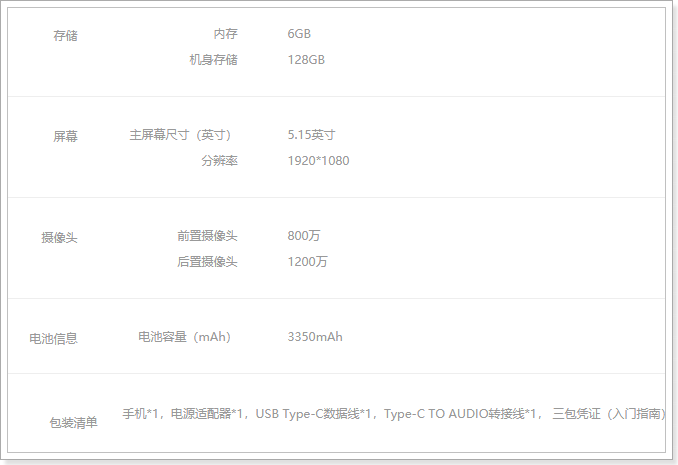
1.9.售后服务
售后服务也可以通过Thymeleaf进行渲染:
<div id="three" class="tab-pane">
<p>售后保障</p>
<p th:text="${detail.afterService}"></p>
</div>
效果:
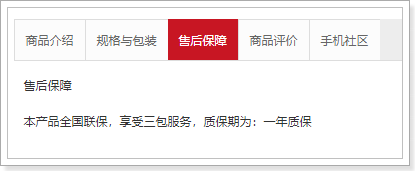






















 328
328











 被折叠的 条评论
为什么被折叠?
被折叠的 条评论
为什么被折叠?








